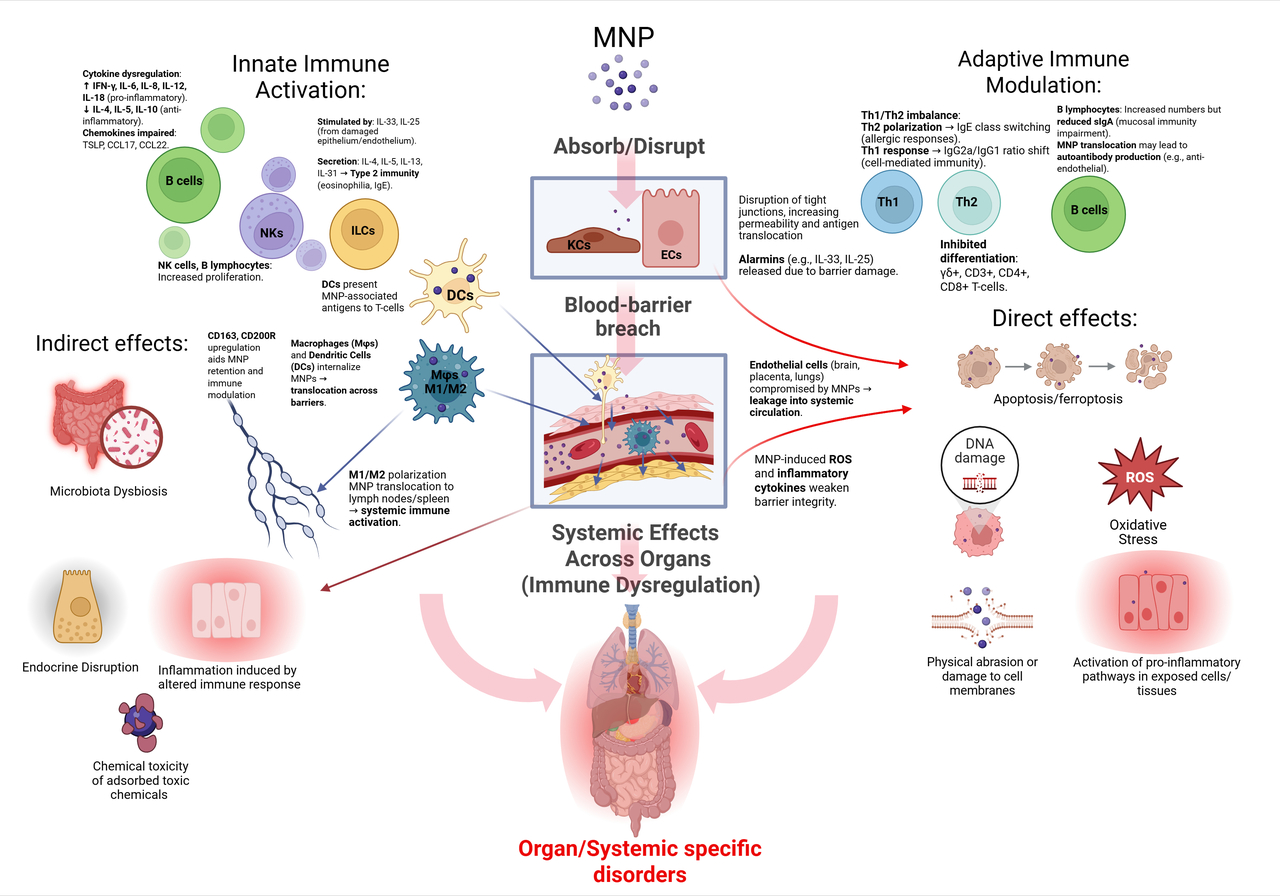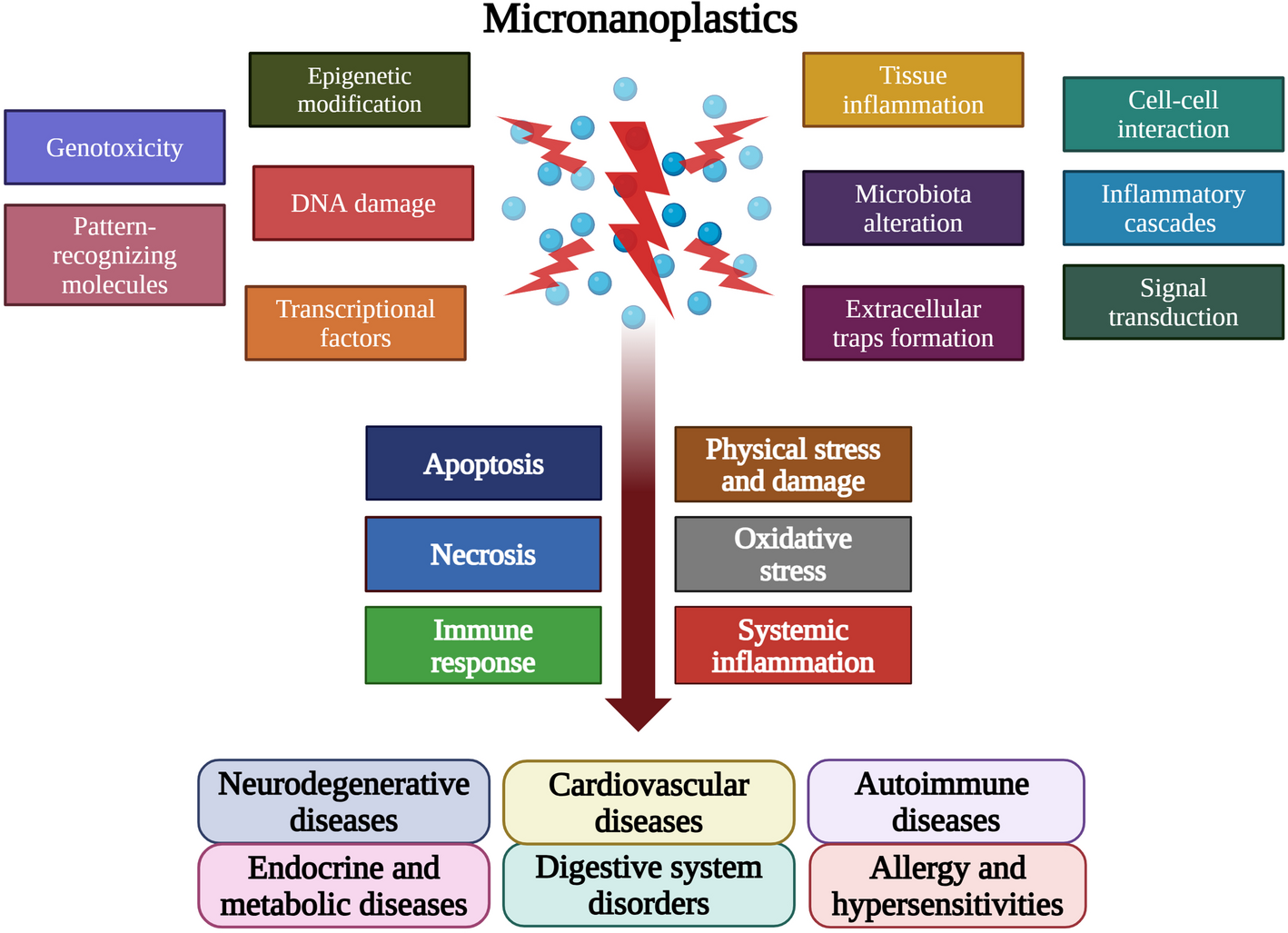The Invisible Threat: Why Micronanoplastics are a Systemic Immune Problem Across All Organ Systems
Published in Earth & Environment and Immunology

The Spark: Why This Review Now?
Over the last few years, research has confirmed that we ingest and inhale thousands of micronanoplastic (MNP) particles daily. Yet, the scientific community often operates in silos—studies on pulmonary effects are disconnected from those on reproductive failure or neurotoxicity.
This fragmentation led us to a crucial question: Is there a common mechanism linking these disparate adverse outcomes? We realized the scientific landscape required a comprehensive synthesis that connected these isolated "islands" of data, defining MNPs as a systemic, immunity-driven health problem.
The Challenge: Mapping the Immune Highway
The task was colossal. We had to synthesize evidence from human, animal, and in vitro models, covering eight major body systems (nervous, endocrine, respiratory, digestive, and others).
The greatest challenge was reconciling the vast differences in MNP data—particles varied in shape, size, material, and concentration across studies. We needed to identify a universal language of toxicity that could explain why such diverse particles lead to such consistently alarming pathologies.
Our Key Finding: Inflammation is the Common Thread
Our analysis revealed that MNPs are not passive, inert particles; they are active disruptors of cellular processes. The core mechanism of their harm is a cascading immune dysfunction, primarily manifesting through two pathways:
-
Oxidative Stress: MNPs induce excessive production of free radicals, damaging cells across all organs.
-
Immune Dysregulation: The particles trigger persistent, low-grade inflammation that can contribute to neuroinflammation, endocrine disruption, and other chronic illnesses.
In essence, we found that the immune system acts as the highway through which MNPs exert their systemic effects across the entire body.
The Research Agenda: What Happens Next?
Our review is not an endpoint; it is a roadmap. It’s a clear call to action for the scientific community. To effectively combat this global threat, standardization is essential. We urge researchers to:
-
Standardize Protocols: Adopt unified testing protocols and MNP characterization metrics to make results truly comparable globally.
-
Focus on Nanoplastics: Increase research on the smallest fraction—nanoplastics—as their capacity to cross biological barriers (like the blood-brain and placental barriers) presents the most significant threat.
-
Transition to Clinical Relevance: Develop clinical intervention and prevention strategies to protect human health from this pervasive environmental danger.
Follow the Topic
-
Discover Medicine

This is a fully open access, peer-reviewed journal that supports multidisciplinary research and policy developments across the fields of medical and clinical science.
Ask the Editor - Immunology, Pathogenesis, Inflammation and Innate Immunity
Got a question for the editor about the complement system in health and disease? Ask it here!
Continue reading announcementRelated Collections
With Collections, you can get published faster and increase your visibility.
Metabolic Wellness: Addressing the Health Prevention and Management of Obesity and Type 2 Diabetes
Obesity and type 2 diabetes mellitus (T2DM) represent two of the most pressing and interlinked public health challenges of the 21st century. With escalating global prevalence, these conditions are no longer confined to affluent nations, but are rapidly rising in developing countries, driven by sedentary lifestyles, dietary transitions, environmental factors, and genetic predispositions. This Collection aims to provide a comprehensive and multidisciplinary examination of the complex biological, clinical, epidemiological, and socio-environmental mechanisms that underpin the obesity-diabetes nexus.
We invite contributions that critically explore the pathophysiological pathways linking adiposity to insulin resistance, including the roles of chronic low-grade inflammation, adipokine signaling, mitochondrial dysfunction, and gut microbiota. Research addressing genetic and epigenetic factors, pediatric and gestational diabetes, ethnic and gender disparities, and emerging biomarkers are particularly encouraged. Furthermore, we seek discussions on intervention strategies encompassing pharmacological treatments, nutritional modulation, lifestyle interventions, and public health policy frameworks that target obesity and T2DM prevention.
This Collection will serve as an essential reference for endocrinologists, diabetologists, obesity researchers, public health professionals, nutritionists, molecular biologists, and policymakers. By integrating global perspectives and cutting-edge research, it aspires to advance understanding and foster collaborative efforts toward mitigating this dual epidemic. Prospective authors are encouraged to contribute original chapters, clinical insights, or region-specific case studies that align with the Collection’s central theme such as:
1. Gut Microbiota and the Obesity-Diabetes Axis
2. Oxidative Stress and Mitochondrial Dysfunction in Obesity and T2DM
3. Epigenetic Modifications in Obesity and Glucose Metabolism Disorders
4. Artificial Intelligence and Digital Health Tools in Managing Obesity and Diabetes
5. Community-Based Interventions for Reducing Obesity and Diabetes Prevalence
Keywords: Obesity, BMI, Diabetes, Pathophysiology, Metabolic Syndrome, Cardiovascular diseases
Publishing Model: Open Access
Deadline: Mar 31, 2026
New Trends in Clinical Laboratory Medicine
The main purpose of the issue is to explore novelties in clinical biochemistry and laboratory medicine. The issue aims to cover different emerging topic.
One significant trend in clinical laboratory medicine is the use of automation, machine learning and artificial intelligence (AI) to improve laboratory workflows, reduce turnaround times, and enhance the accuracy of laboratory test results. Laboratories are adopting automated systems that can perform sample processing, analysis, and result reporting with minimal human intervention, resulting in faster and more efficient testing processes.
Furthermore, there has been a growing interest in using machine learning algorithms to analyze large amounts of data generated by clinical biochemistry tests. These techniques can also help to identify new biomarkers, develop more accurate diagnostic tools, and improve treatment outcomes.
The development of new biomarkers for disease diagnosis and monitoring can improve disease detection and treatment.
In this context, metabolomics can be applied to biomarker discovery, drug development and personalized medicine.
Another ongoing trend in clinical biochemistry is the increased use of personalized medicine. This approach involves tailoring medical treatment to the individual patient's unique characteristics, such as their genetics and metabolism. Advances in genomic sequencing and other technologies have made it easier to identify specific biomarkers and genetic mutations that can be targeted with personalized therapies. Moreover, new rapid diagnostic techniques are requested to tackle problems such as antibiotic resistance. Overuse or misuse of antibiotics recommended by physicians/self-medication at the time of infection has meant that drug-resistant pathogens have become a major healthcare issue, with millions of reported cases every year. Rapid diagnostics plays a pivotal role in the treatment of bacterial infection. For the timely treatment of patients, a rapid antimicrobial susceptibility test (AST) is urgently needed. Advanced diagnostics would allow clinicians to more quickly determine the most effective treatment, reduce the nonspecific use of broad-spectrum antimicrobials, and facilitate enrollment in new antibiotic treatments. A rise in antibiotic resistance is a certainty, therefore, we must develop technologies that will permit rapid AST (within few hours) and are non-invasive (saliva- or urine-based) or minimally invasive. At the same time, Point-of-Care Testing (POCT) has gained significant importance in healthcare due to its potential to provide rapid and accurate diagnostic results directly at the patient's bedside or in a non-laboratory setting. POCT indeed offer rapid, accessible, and versatile diagnostic capabilities, allowing for enhanced patient management, reduced turnaround time, and improved healthcare outcomes. POCT has the potential to revolutionize the way diagnostic testing is performed and integrated into healthcare systems.
SUMMARY
Clinical Biochemistry and Laboratory Medicine have a central role in achieving a quick and correct diagnosis. This Special Issue plans to give an overview of the most recent advances in the field.
This special issue is aimed at providing innovative contribution on new trends and advances on clinical biochemistry related to different topics.
Potential topics include, but are not limited to:
Automated systems
Biomarkers
Metabolomics, Volatolomics
Machine learning, Artifical Intelligence
Rapid diagnostics
POCT
Keywords: POCT, Biomarkers, Metabolomics, Volatolomics, Machine learning, Artifical Intelligence, Rapid diagnostics, Automated systems
Publishing Model: Open Access
Deadline: Jan 30, 2026





Please sign in or register for FREE
If you are a registered user on Research Communities by Springer Nature, please sign in